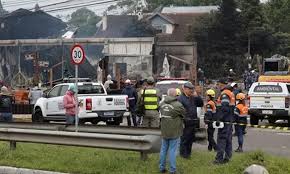Catastrophe on BR‑251: A Tragic Collision, a Community in Shock, and Questions That Demand Answers
Late Tuesday night, what should have been a routine journey home turned into one of the most devastating accidents in recent memory along Brazil’s BR‑251 in Grão Mogol. Witnesses describe a sudden, catastrophic collision between a van and a truck—but as investigators sift through the wreckage and statements, a haunting question remains: could this disaster have been prevented, or was negligence hiding in plain sight?
A Deadly Night

On the night of Tuesday, May 13, 2025, a van carrying seasonal workers collided head-on with a truck along BR‑251 in northern Minas Gerais. The crash left nine people dead and at least ten others injured, with rescue teams scrambling to respond amid chaos.
Emergency services—firefighters, SAMU (mobile medical service), the Civil Police, and the Federal Highway Police (PRF)—worked into the night to extricate victims, attend to the injured, and secure the scene.
Tragically, nine individuals lost their lives. One of the youngest victims was a 4‑year-old child traveling with their family.
Chronology
The ages of the deceased range from 4 to 52 years.
Chronology
Many of the bodies had to be identified by facial recognition or fingerprint analysis, as some victims did not carry identification papers.
Initial Clues: Lane Violation, Road Conditions, and “Irregular” Transport
Truck Crossed Into Wrong Lane
Preliminary findings from the Minas Gerais Civil Police indicate that the truck veered into the oncoming lane and struck the van directly. Accident expert Hugo Leonardo cited skid marks, drag patterns, and the geometry of tire grooves as evidence pointing to the truck’s deviation. “This was the decisive factor,” he stated.
In his view, the collision “would likely not have occurred had the truck remained in its lane.”
Chronology
A full technical report is expected within 30 days and is likely to inform potential legal charges over civil or criminal liability.
Weather and Road Conditions Under Scrutiny
At the time of the crash, moderate rain and fog were reported along the stretch of BR‑251. The wet surface may have played a role, reducing traction and complicating vehicle control. Investigators are also examining whether excessive speed, poor visibility, or mechanical failure contributed to the loss of control.
This segment of BR‑251 is known for a history of accidents—particularly under inclement weather—making safety oversight a key concern in the investigation.
Unauthorized Van, Vulnerable Passengers
One of the more disturbing revelations is that the van was operating without authorization for interstate passenger transport. The National Land Transport Agency (ANTT) confirmed that the vehicle lacked the legal permit required to carry passengers across states.
The van was carrying 19 seasonal workers returning home to Ceará after harvesting in Goiás and Minas Gerais. Towns like Prata, Araguari, and Catalão were reported as pickup points.
The use of clandestine transport by rural laborers—driven by cost constraints and limited options—has become a fatal vulnerability.
The Human Toll: Lives Lost, Families Shattered
The loss cut across ages, states, and families. The victims included men, women, and children returning to their homes after long, arduous workdays.
One victim, a 4‑year-old child from Uberlândia (MG), underscores the tragedy’s personal weight.
Another victim was a 29‑year-old man from Crato (CE).
An elderly man remains unidentified as authorities continue forensic investigations.
Chronology
Families must now cope not only with grief, but with unanswered questions about how such a calamity could happen—and what accountability might follow.
Responsibility and Reaction
The truck company, OPR Logística, issued a statement expressing sorrow and pledging full cooperation with the investigation. They asserted that safety is a priority in their operations, though little has yet been disclosed about the driver’s history, the truck’s maintenance record, or operational practices.
Meanwhile, federal and state authorities have launched a formal inquiry. The upcoming expert technical report will be pivotal in determining whether negligence, mechanical failure, or environmental factors are to blame.
Could It Have Been Avoided?
While investigations are ongoing, several red flags already invite scrutiny:
Lane crossing by the truck is a primary suspect in the collision’s trigger.
Poor weather conditions, combined with possible over-speeding or misjudgment, may have reduced reaction margins.
Unauthorized transport placed vulnerable workers into a potentially unsafe vehicle without oversight.
Safety enforcement gaps in maintaining road infrastructure, vehicle inspections, and oversight on highways like BR‑251.
Together, they point to systemic flaws rather than a singular accident.
Aftershock: A Highway Under Pressure
In the hours following the crash, additional accidents struck the same highway. In Francisco Sá, a truck rolled over, and elsewhere in Salinas, another truck crash left the driver injured. These incidents further highlight the precarious nature of BR‑251 under heavy traffic and inclement conditions.
News Minimalist
In the public sphere, anger and grief are mounting. For many, this is not just another tragic news headline—it’s a stark reminder of how loss often speaks to deeper structural failures: in regulation, infrastructure, and social inequality.
Conclusion: A Tragedy That Demands Accountability
The collision on BR‑251 is more than a sorrowful chapter in Brazil’s accident statistics. It is a compelling case study in how preventable elements—lane discipline, legal oversight, weather conditions, and infrastructural maintenance—interact with human risk.
Nineteen people were crammed into an unauthorized van; one wrong turn sent nine of them to death. Those who survived carry not only physical injuries, but psychological scars and a trail of questions. And families left behind demand more than condolences—they demand accountability.
As authorities compile reports and assign responsibility, the broader conversation must not fade. This disaster underscores urgent imperatives:
Strengthen enforcement of legal transport permits, especially for vulnerable workers
Improve highway safety systems—guardrails, signage, lighting, drainage
Mandate stricter inspections for commercial vehicles
Incentivize safe alternatives for rural and low-income passenger transport
Grief in Grão Mogol is fresh and deep. But in the weeks ahead, the nation must demand rigor, transparency, and justice. For those who perished, and all who remain, the cost of silence is far too high.
